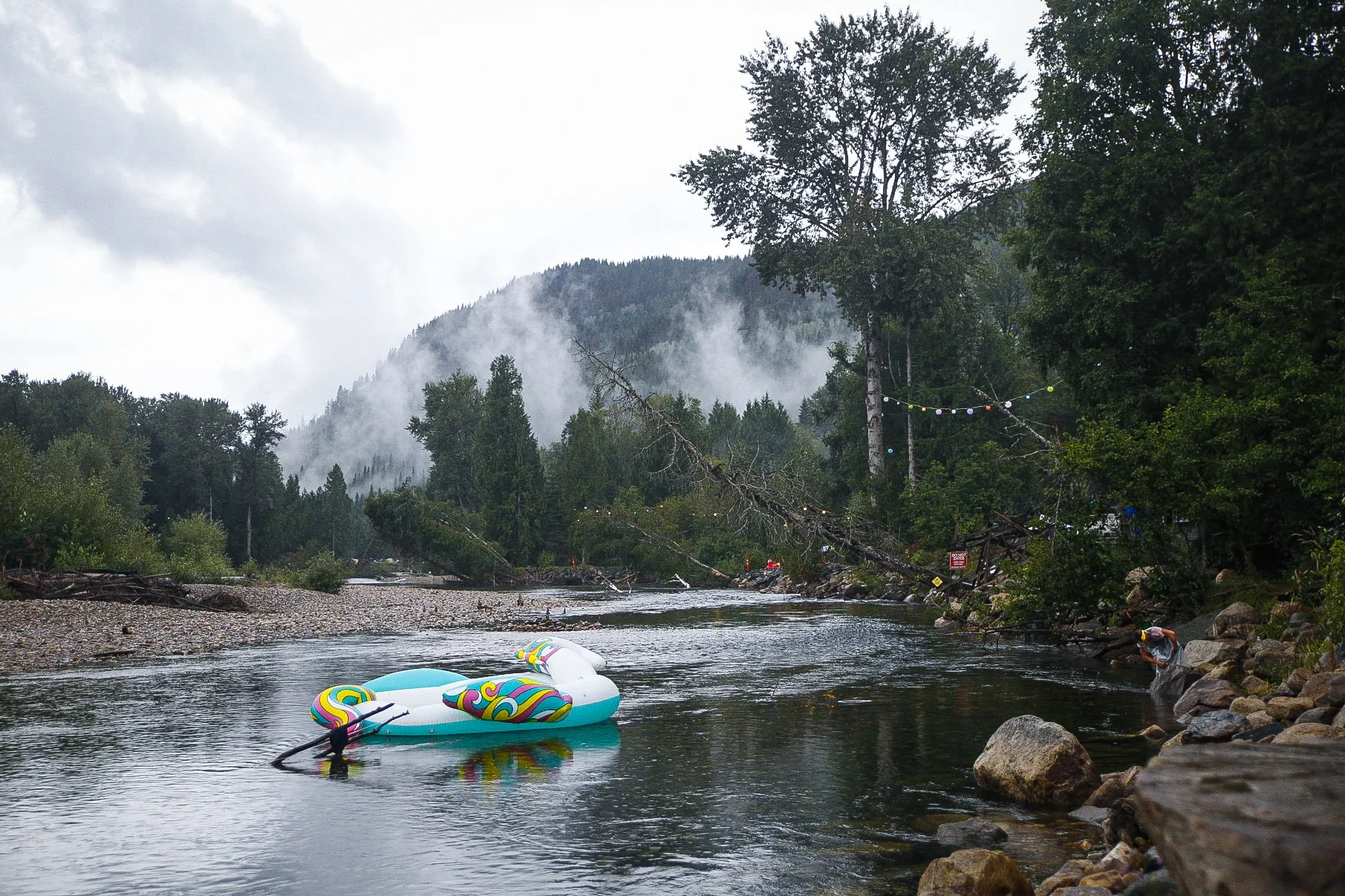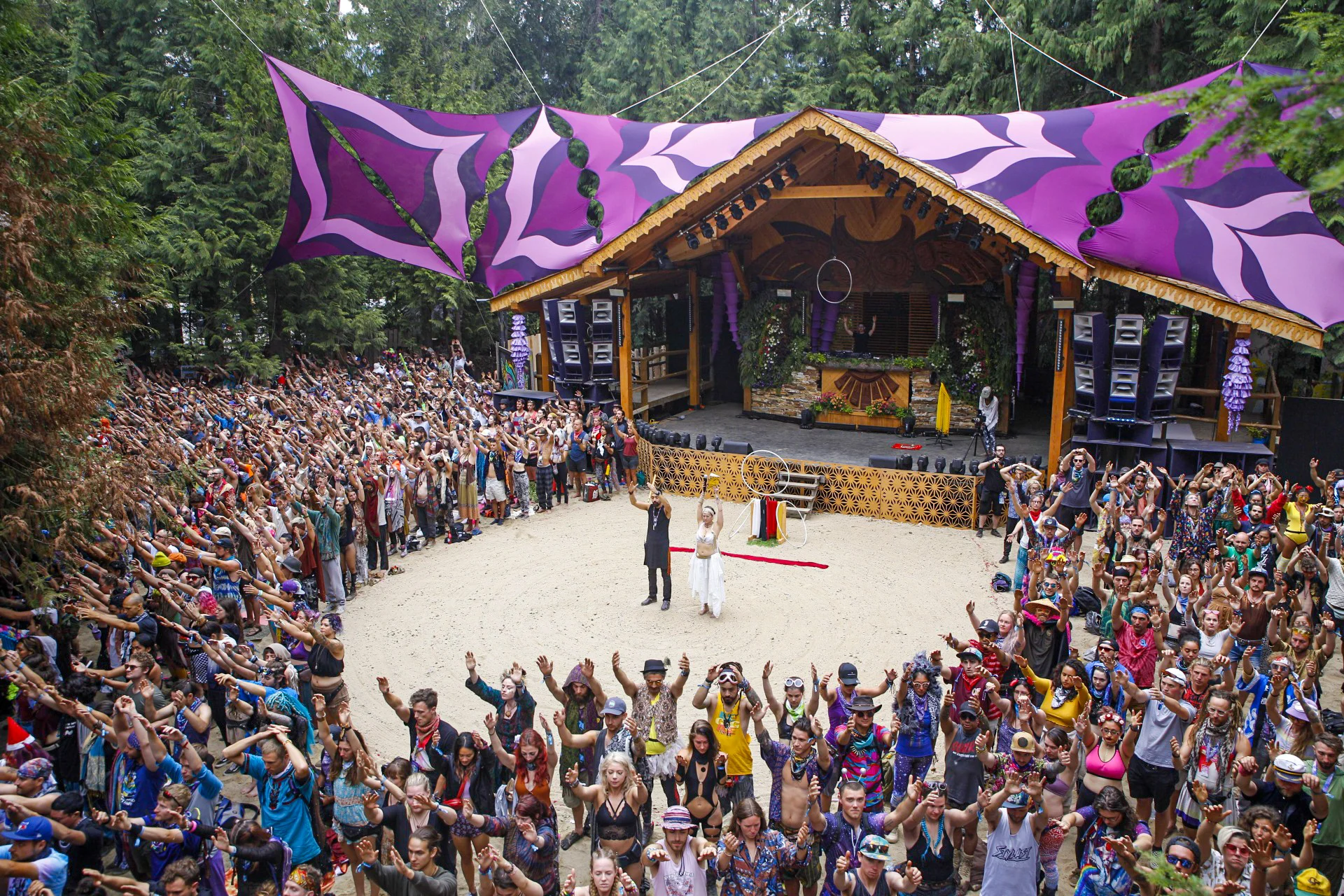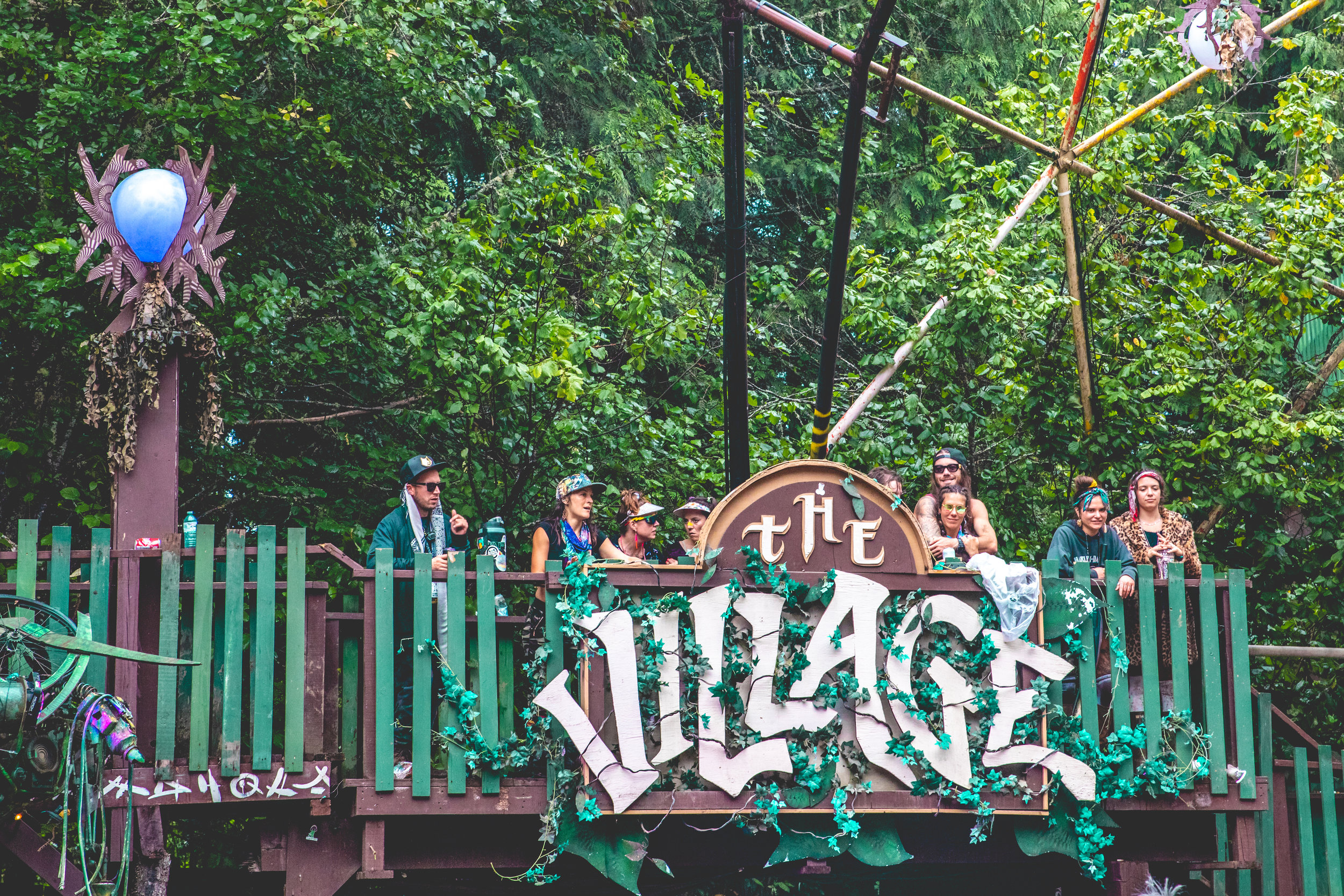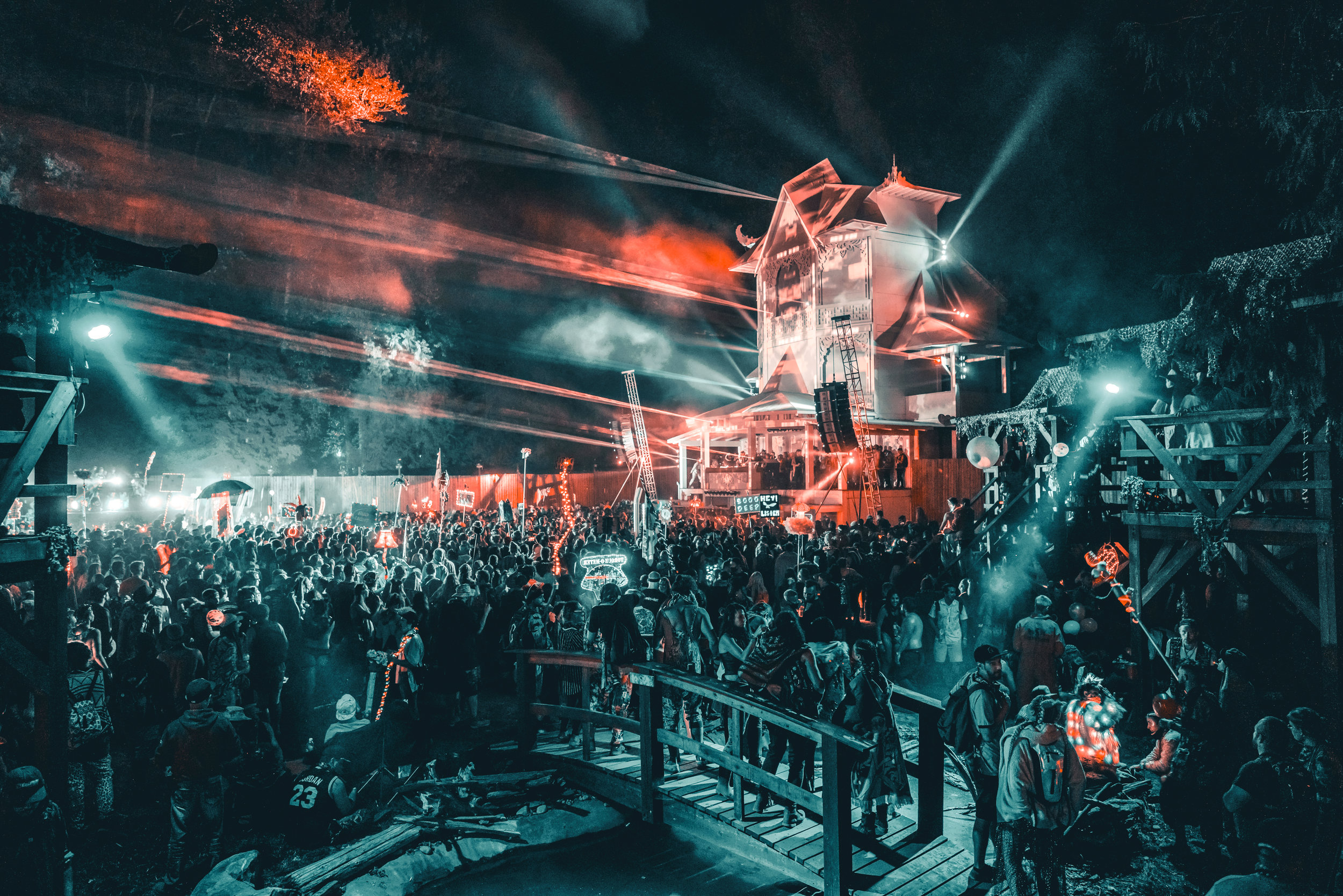"It Was Really About the People & the Land" - A Weekend At Shambhala
(Credit: ConcertSocks)
Flipping through my notes from Shambhala Music Festival, a few sloppy, scribbled lines stand out:
We’ve got what it takes
To make this world a better place
And make our children safe
It’s all up to me
It’s all up to you
That’s a vocal sample from soundcheck before A Tribe Called Red’s Sunday night performance at the Ampitheater, one of six stage environments at Shambhala, which ran from Thursday, August 8 through morning on Monday, August 12 at the Salmo River Ranch in British Columbia, Canada for the 22nd year in a row.
This Ottawa-based act blends all sorts of electronic music - house, hip-hop, dubstep, drum and bass, hardstyle, Jersey club - with First Nation drumming and chanting to initiate an “electric pow wow”. Participating was liberating yet chilling (“My people will sell our bracelets by the roadside. Your people will play golf, and eat hot hors d'oeuvres.”)
Their heavy performance said “dance like you mean it, but don’t forget what’s happening behind the music.” It was like a microcosm of Shambhala as a whole. The event hosts many of the best electronic acts in the world, but the music can also be seen as a means to an end. Music is just the centrifugal force around which a community, decades in the making, gathers to celebrate its renegade culture.
(Credit: ConcertSocks)
A British Columbia local named Osprey and perhaps others conceived the idea for Shambhala in the late 1990s. Osprey came from the psychedelic trance scene of Goa, India during its heydays, where interactions between western counter culture and Hinduism embedded eastern spirituality into the rave scene. He would tragically pass away in a car accident, but his vision for a music festival in the Kootenay Mountains would live on through the several hundred local fans, promoters, and musicians who started it.
During the Vietnam War, draft dodgers from the United States hid out in the Western Kootenays. At the turn of the 20th century, the Dukhobors, an anti-state Russian Christian sect, settled there after being exiled for their unorthodox beliefs. There’s always been a durable marijuana culture. It’s fertile ground for a party like Shambhala, which built upon the existing counter culture in this isolated region.
“The surrounding area is sort of a fortress. It’s not near any major highways, there’s mountains in every direction, deep valleys, big mountains all around. It’s not on an interstate or even a big provincial highway.” That’s Tall Brian, who for over a decade has managed Shambhala’s artist lounge and accommodations, an “outdoor hotel” as he calls it. “The event is kind of a pilgrimage in that way. You have to go there.”
Naasko is a DJ whose performed at every Shambhala since 1999 besides a few when he worked and performed at Boom Festival in Portugal. “There’s a pursuit of freedom that exists here at Shambhala,” he said. That first year he came from Vancouver, worked a food stand, talked his way into a set, and would move to the nearby city of Nelson not long afterwards. “A giant inflatable buddha like 40 feet tall out on the highway brought people into this little mystical enclave here in the woods,” he recalled.
I spoke to both of them on a rainy Sunday in a big, twisting tree house lounge before Naasko’s 6:00pm set. “It started really humbly,” said Brian. “Just local people putting stuff together. I mean the early stages were just really rudimentary tarps and small systems. I have a photo of the Living Room when it was two speakers and a tarp.”
The Grove (Credit: ConcertSocks)
The Grove (Credit: ConcertSocks)
As the climate, laws, music, people, and the popularity of the entire electronic music enterprise has changed, Shambhala has changed, too. But it’s managed to preserve that special something. “I think the essence is still there. That’s what sustains its popularity. The festival embodies a lot of the freedom essence that’s not found in other places. That’s the appeal to the working masses in Calgary and Edmonton and Saskatchewan. When they think about coming here, it means so much to them.”
How? It’s put on by an enduring crew that comes back year after year, it’s become part of Western Canadian culture, and it’s centered around ideas that don’t lose value with time or trends; respect for the Earth and oneself; reverence for higher powers; independence from corporate influence; passion for good music.
People take care of the 500-acre ranch. Beside the river in the early morning sun, Jack Elliman sweeps his arm out across the pristine riverbank. “There used to be trash all along here. Now when people come to Shambhala they are educated by Shambassadors, the GRC and festi veterans pretty quickly. They learn how important it is to respect the land, the river, and each other, and that mind frame is contagious.”
Jack volunteers with the Shambhala Green River Collective which has been cleaning the Salmo River since 2011. He also runs the event’s cigarette butt disposal and recycling operation and invented the Pocket Ashtray (yes those pocket ashtrays), a Shambhala staple. There’s butt buckets all over the grounds, the Grove has a smoke-free dance floor, and nature’s abundance is itself a persuasive reminder not to litter. “Then they take what they learn here and bring it back to wherever they're from,” says Jack. “That's the true transformational festival."
The Amphitheater (Credit: Banana Cam)
The Amphitheater (Credit: Banana Cam)
There’s Camp Clean Beats, a camping area sober festival goers who are sober or in recovery. Shambhala is perhaps most famous for its harm reduction work, from free drug testing to sanctuary spaces for women. Select weekend workshops encouraged attendees to respect themselves and party responsibly like “Cannabis: Gateway or Exit?” and “Psychedelics and Intimate Relationships.” A woman approached me during the Saturday night thunderstorm and handed me a sticker with the Shambhala SOS telephone number on it. “If you’re in trouble or you see someone who needs help, just call.”
Festivals, especially transformational festivals, are often seen as departures from the “default world” and Shambhala is no different. But it has also become part of the regular culture around those parts. The province of British Columbia actively sponsors the event. A woman named Celia from Vernon, BC, where producers JPOD and ATYYA grew up, first came to Shambhala 15 years ago and has volunteered several times since. During ATYYA at the Grove on Saturday, her son emerged from the crowd to her delight with his totem, girlfriend, and wide electric eyes.
I camped on a rented property in Nelson after the event. Lo and behold, the owner DJed at Shambhala twice and went to high school with lead organizer and Salmo River Ranch owner Jimmy Bundschuh. “Everyone around here knows the Bundschuh’s,” she said. In Calgary, I stayed with a friend who I know through channels completely unrelated to Shambhala. “But you know that pond in the woods behind the Labyrinth [now the Grove],” he asked me. “I built that one year when I was curating ambient music on the side stage back there [now the Cedar Lounge].”
The Village (Credit: ATS Photography)
The Village (Credit: James Coletta)
The Shambhala crew, including volunteers, numbered about 2,500 people this year. That’s about 15-20% of everyone on site, an unusually high number. From long-serving stage managers down to first-year Australian volunteers, there’s an elaborate credential system for the crew. I saw a dog that was more credentialed than I was. A man with a blue beard who must be at least 75 years old sits guarding a gigantic pyramid in the Fractal Forest. A man with one eye and sharp teeth guards the entrance to the stage. So much of the crew clearly returns year after year, and most are Canadian. The infrastructure at Shambhala - world class stage, lighting, and sound infrastructure, tree houses, terraces, villages, pathways, gardens, fences, nooks and crannies - was built by generations of teams. I met at least six dudes throughout the weekend who “cut and strip wood”.
“It was really about the people and the land,” Naasko recalled as he unpacked twenty years of memories.
“Same,” I thought to myself. But I’d be remiss if I finished this piece without hitting on musical highlights from that interdimensional weekend.
After a flight cancellation and a pedal-heavy haul from Calgary through plains and peaks, I pulled in at sunset and walked into the Fractal Forest for the first time during the Westwood Recordings takeover. New Zealand producer K+Lab was landing the mothership, playing keytar on stage in that old-growth 360-degree sound garden. Coming from Kelowna, BC just west of Shambhala, Stickybuds followed and practically looked like a gigantic tree the way he dominated the energy of that space. After starting with wicked drum and bass he ran through his signature electro funk selectors including “Crooked Politicians” off his first album, which he dedicated to all the crooked politicians around the world.
The magnitude of Shambhala hit hard Sunday night. During one time slot Rusko was playing at the Village, Troyboi the Amphitheater, Bonobo the Grove, Zeds Dead the Pagoda, and Silk City (Diplo and Mark Ronson) at the Fractal Forest. The entire grounds were saturated with mud and the energy was beyond feverish.
(Credit: DIVISUALS)
The Pagoda (Credit: James Coletta)
Late that night I found a deep heads’ delight. kLL sMTH absolutely wrecked the Ampitheater and spun me down to the Grove for Stray (one half of Ivy Lab). He was laying it in there, drilling dark drum and bass but pausing now and then to express gratitude to the audience’s for their openness. “You’re a pretty open lot. This is some of my favorite music, and it’s been years since I’ve played it.” Tor from Vancouver followed him with a perfect, grounding sunrise set for a bright, colorful capacity crowd. By that time, only the strongest psychedelic sound warriors were still kicking. But at Shambhala, that’s like everybody.
One more story from Brian is worth sharing.
When I arrived at reception today I saw this super average looking young kid, Alberta license plates. He was by himself but was clearly so stoked. I was bringing in my work crew for like the thirteenth time and was like, “yea whatever this is gonna take a long time to get these credentials.” But the guy was just so excited to see us. I think there’s something that happens as people enter. Barriers break down and there’s this whole spirit that’s there; a friendliness, a genuineness that’s contagious. It takes on different forms and qualities. For us, it was a very different experience. But for, say, a young Albertan it can feel very transformative. And this kid was like, “what’s up Shamb fam?!” And he wanted to hug us all - total strangers.
The Living Room (Credit: Banana Cam)
The Living Room (Credit: ConcertSocks)
Shambhala is probably the best that the electronic music culture has to offer right now, and that’s pretty damn impressive. DJ Mag recognized this by awarding Shambhala as the best festival in North America in 2019. If you’re part of this culture, and you have the means, experience it at least once. “I’m curious to see what will happen,” said Brian. “22 years going strong. I really feel that Shambhala could sell out in perpetuity. If they kept the numbers and kept the quality. It would be interesting to see where it’s at in 25 or 30 years.”
“If we’re still alive then,” Naasko chuckled.
FOLLOW Shambhala Music Festival: Official / Facebook / Instagram












